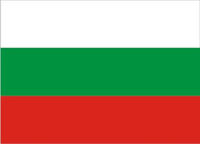''...I enjoyed every minute of the tour and I attribute it most of all to the knowledge and dedication of both Rozle and Klemen...''
Destinations

BULGARIA
- GENERAL INFORMATION
Location:Southeastern Europe, bordering the Black Sea, between Romania and Turkey
Border Countries: Greece 472 km, Macedonia 162 km, Romania 605 km, Serbia 344 km, Turkey 223 km
Area: 110,879 sq km
Population:7,144,653
Capital City: Sofia (population 1.226 million)
Religions:Eastern Orthodox 59.4%, Muslim 7.8%, other (including Catholic, Protestant, Armenian Apostolic Orthodox, and Jewish) 1.7%, none 3.7%, unspecified 27.4%
Government type:parliamentary republic
Coastline: 354 km (Black Sea)
Highest point: Musala 2,925 m
Roadways: 19,512 km, paved: 19,235 km (includes 458 km of expressways), unpaved: 277 km
Time difference: UTC/GMT +2:00
National currency:Bulgarian Lev
International dialing number: +359
Electricity:Bulgaria's electrical current is 230 V; 50 cycles and sockets take the standard continental European dual round-pronged plugs.
- VISA
For visitors from most countries (EU, USA, etc) a visa is not needed. Only a valid passport is required
- CLIMATE
temperate; cold, damp winters; hot, dry summers
- TERRAIN
mostly mountains with lowlands in north and southeast
- LANGUAGES
Bulgarian (official) 76.8%, Turkish 8.2%, Roma 3.8%, other 0.7%, unspecified 10.5%
- ETHNIC GROUPS
Bulgarian 76.9%, Turkish 8%, Roma 4.4%, other 0.7% (including Russian, Armenian, and Vlach), other (unknown) 10%
- HISTORICAL BACKGROUND
The Bulgars, a Central Asian Turkic tribe, merged with the local Slavic inhabitants in the late 7th century to form the first Bulgarian state. In succeeding centuries, Bulgaria struggled with the Byzantine Empire to assert its place in the Balkans, but by the end of the 14th century the country was overrun by the Ottoman Turks. Northern Bulgaria attained autonomy in 1878 and all of Bulgaria became independent from the Ottoman Empire in 1908. Having fought on the losing side in both World Wars, Bulgaria fell within the Soviet sphere of influence and became a People's Republic in 1946. Communist domination ended in 1990, when Bulgaria held its first multiparty election since World War II and began the contentious process of moving toward political democracy and a market economy while combating inflation, unemployment, corruption, and crime. The country joined NATO in 2004 and the EU in 2007.
- ECONOMY OVERVIEW
Bulgaria, a former communist country that entered the EU on 1 January 2007, averaged more than 6% annual growth from 2004 to 2008, driven by significant amounts of bank lending, consumption, and foreign direct investment.
Successive governments have demonstrated a commitment to economic reforms and responsible fiscal planning, but the global downturn sharply reduced domestic demand, exports, capital inflows, and industrial production. GDP contracted by 5.5% in 2009, and has been slow to recover in the years since.
Despite a favorable investment regime, including low, flat corporate income taxes, significant challenges remain. Corruption in public administration, a weak judiciary, and the presence of organized crime continue to hamper the country's investment climate and economic prospects.
- MAIN INDUSTRIES
electricity, gas, water; food, beverages, tobacco; machinery and equipment, base metals, chemical products, coke, refined petroleum, nuclear fuel
- FLAG DESCRIPTION
three equal horizontal bands of white (top), green, and red; the pan-Slavic white-blue-red colors were modified by substituting a green band (representing freedom) for the blu


